2017 MERCEDES-BENZ E43AMG LED
[x] Cancel search: LEDPage 49 of 482
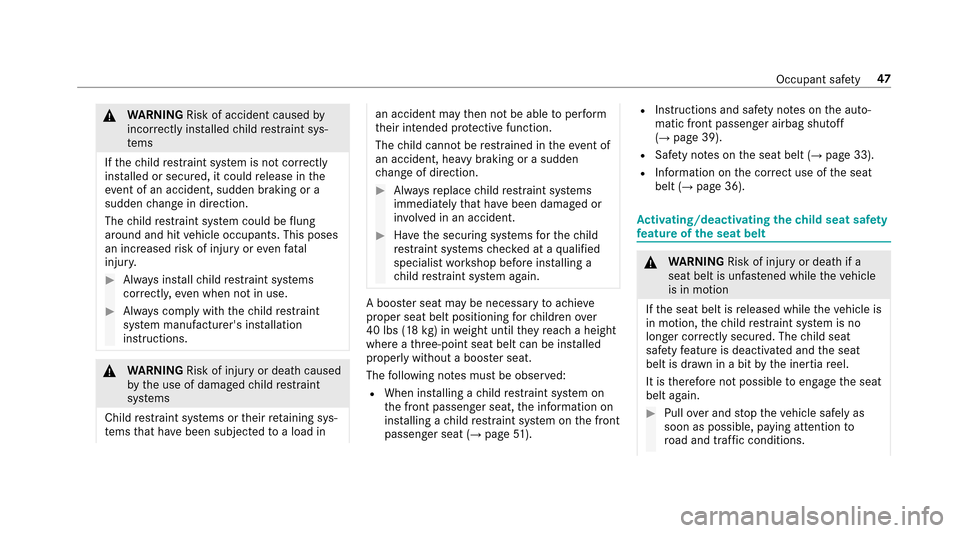
&WARNING Risk of accident caused by
incor rectly ins talled child restra int sys‐
te ms
If th ech ild restra int sy stem is not cor rectly
ins talled or secured, it could release in the
ev ent of an accident, sudden braking or a
sudden change in direction.
The child restra int sy stem could be flung
around and hit vehicle occupants. This poses
an increased risk of injury or even fata l
injur y.
#Always ins tallch ild restra int sy stems
cor rectl y,eve n when not in use.
#Alw ays comply with thech ild restra int
sy stem manufacturer's ins tallation
instructions.
& WARNING Risk of injury or death caused
by the use of damaged child restra int
sy stems
Child restra int sy stems or their retaining sys‐
te ms that ha vebeen subjec tedto a load in
an accident may then not be able toper form
th eir intended pr otective function.
The child cannot be restra ined in theeve nt of
an accident, heavy braking or a sudden
ch ange of direction.
#Alw aysre place child restra int sy stems
immediately that ha vebeen damaged or
in vo lved in an accident.
#Ha ve the securing sy stems forth ech ild
re stra int sy stems checked at a qualified
specialist workshop before ins talling a
ch ild restra int sy stem again.
A boos ter seat may be necessary toachie ve
proper seat belt positioning forch ildren over
40 lbs (18 kg) in weight until they reach a height
where a thre e-point seat belt can be ins talled
proper lywithout a boos ter seat.
The following no tes must be obser ved:
RWhen ins talling a child restra int sy stem on
th e front passenger seat, the information on
ins talling a child restra int sy stem on the front
passenger seat (
→page 51).
RInstructions and saf etyno tes on the auto‐
matic front passenger airbag shutoff
(
→page 39).
RSaf etyno tes on the seat belt (→page 33).
RInformation on the cor rect use of the seat
belt (→page 36).
Ac tivating/deactivating the child seat saf ety
fe ature of the seat belt
&
WARNING Risk of injury or death if a
seat belt is unfas tened while theve hicle
is in motion
If th e seat belt is released while theve hicle is
in motion, thech ild restra int sy stem is no
longer cor rectly secure d. Thechild seat
saf etyfe ature is deactivated and the seat
belt is dr awn in a bit bythe inertia reel.
It is therefore not possible toengage the seat
belt again.
#Pull over and stop theve hicle safely as
soon as possible, paying attention to
ro ad and traf fic conditions.
Occupant saf ety 47
Page 50 of 482
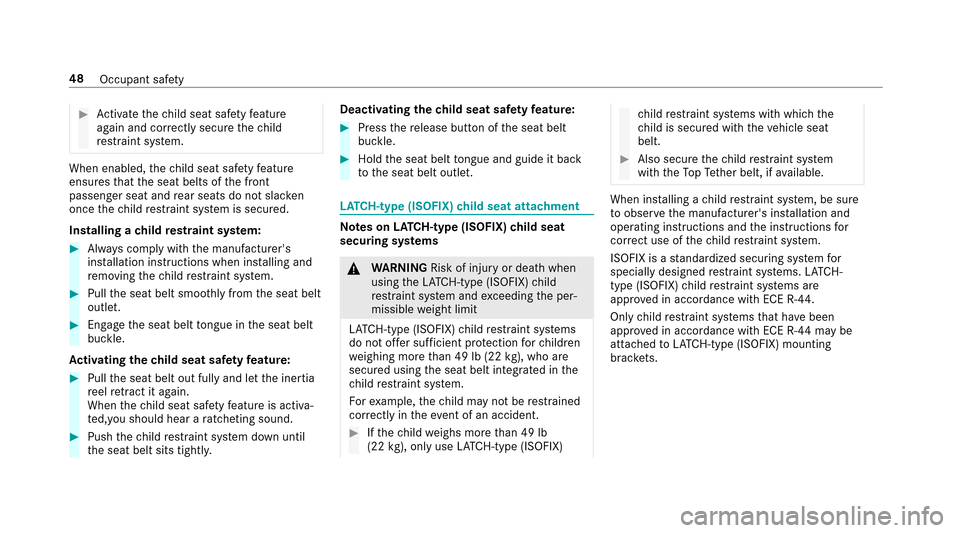
#Activate thech ild seat saf etyfe ature
again and cor rectly secure thech ild
re stra int sy stem.
When enabled, thech ild seat saf etyfe ature
ensures that the seat belts of the front
passenger seat and rear seats do not slac ken
once thech ild restra int sy stem is secured.
Installing a child restra int sy stem:
#Alw ays comply with the manufacturer's
ins tallation instructions when ins talling and
re moving thech ild restra int sy stem.
#Pull the seat belt smoo thly from the seat belt
outlet.
#En gage the seat belt tongue in the seat belt
buckle.
Ac tivating the child seat saf etyfe ature:
#Pull the seat belt out fully and let the inertia
re el retract it again.
When thech ild seat saf etyfe ature is activa‐
te d,you should hear a ratcheting sound.
#Push thech ild restra int sy stem down until
th e seat belt sits tightly. Deactivating the
child seat saf etyfe ature:
#Press there lease button of the seat belt
buckle.
#Hold the seat belt tongue and guide it ba ck
to the seat belt outlet.
LA TC H-type (ISOFIX) child seat attachment
Note s onLATC H-type (ISOFIX) child seat
securing sy stems
&
WARNING Risk of injury or death when
using theLA TC H-type (ISOFIX) child
re stra int sy stem and exceeding the per‐
missible weight limit
LA TC H-type (ISOFIX) child restra int sy stems
do not of fer suf ficient pr otection forch ildren
we ighing more than 49 lb (22 kg), who are
secured using the seat belt integrated in the
ch ild restra int sy stem.
Fo rex ample, thech ild may not be restra ined
cor rectly in theeve nt of an accident.
#Ifth ech ild weighs more than 49 lb
(22 kg),only use LATC H-type (ISOFIX)
child restra int sy stems with which the
ch ild is secured with theve hicle seat
belt.
#Also secure thech ild restra int sy stem
with theTo pTe ther belt, if available.
When ins talling a child restra int sy stem, be sure
to obser vethe manufacturer's ins tallation and
operating instructions and the instructions for
cor rect use of thech ild restra int sy stem.
ISOFIX is a standardized securing sy stem for
specially designed restra int sy stems. LATC H-
type (ISOFIX) child restra int sy stems are
appr oved in accordance with ECE R-44 .
Only child restra int sy stems that ha vebeen
appr oved in accordance with ECE R-44 may be
attached toLATC H-type (ISOFIX) mounting
brac kets.
48
Occupant safe ty
Page 77 of 482
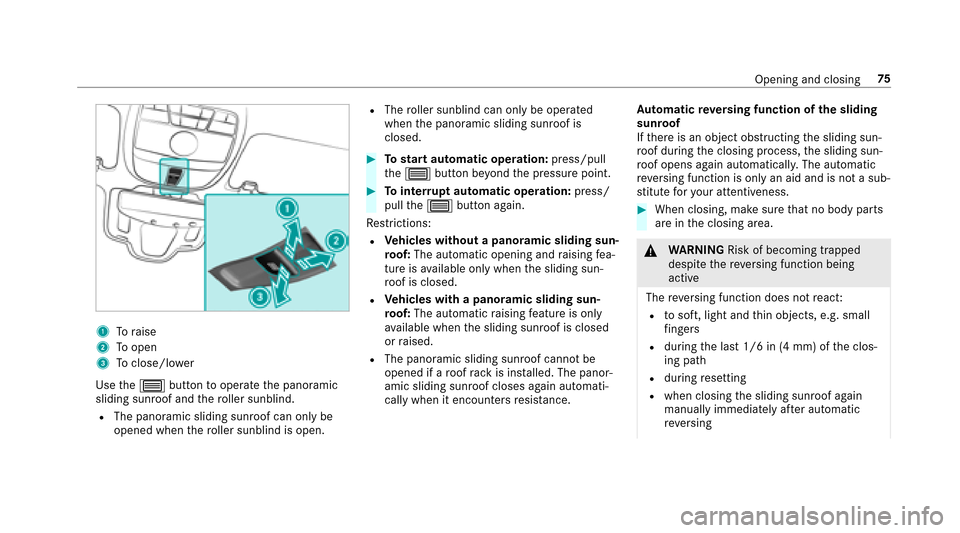
1Toraise
2To open
3Toclose/lowe r
Use the3 button tooperate the panoramic
sliding sunroof and thero ller sunblind.
RThe panoramic sliding sunroof can only be
opened when thero ller sunblind is open.
RThe roller sunblind can only be opera ted
when the panoramic sliding sunroof is
closed.
#To start automatic operation: press/pull
th e3 button be yond the pressure point.
#To inter rupt automatic operation: press/
pull the3 button again.
Re strictions:
RVe hicles without a panoramic sliding sun‐
ro of: The automatic opening and raising fea‐
ture is available only whenthe sliding sun‐
ro of is closed.
RVe hicles with a panoramic sliding sun‐
ro of: The automatic raising feature is only
av ailable when the sliding sunroof is closed
or raised.
RThe panoramic sliding sunroof cannot be
opened if a roof rack is ins talled. The panor‐
amic sliding sunroof closes again automati‐
cally when it encounters resis tance. Au
tomatic reve rsing function of the sliding
sunroof
If th ere is an object obstructing the sliding sun‐
ro of during the closing process, the sliding sun‐
ro of opens again automatically. The automatic
re ve rsing function is only an aid and is not a sub‐
st itute foryo ur attentiveness.
#When closing, make sure that no body parts
are in the closing area.
&
WARNING Risk of becoming trapped
despite there ve rsing function being
active
The reve rsing function does not react:
Rto soft, light and thin objects, e.g. small
fi ngers
Rdu ring the last 1/6 in (4 mm) of the clos‐
ing path
Rduring resetting
Rwhen closing the sliding sunroof again
manually immediately af ter au tomatic
re ve rsing
Opening and closing 75
Page 83 of 482
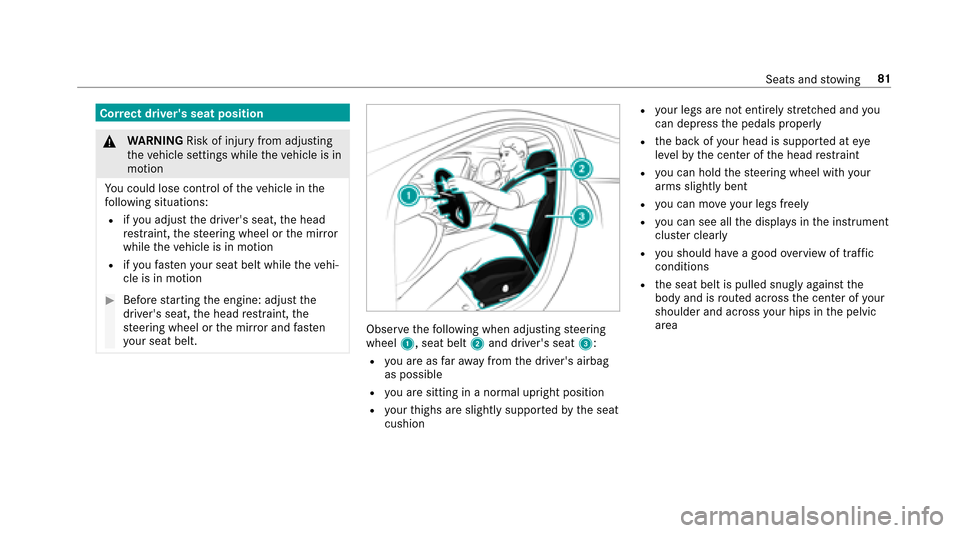
Correct driver's seat position
&
WARNING Risk of injury from adjusting
th eve hicle settings while theve hicle is in
motion
Yo u could lose cont rol of theve hicle in the
fo llowing situations:
Rifyo u adjust the driver's seat, the head
re stra int, thesteering wheel or the mir ror
while theve hicle is in motion
Rifyo ufa sten your seat belt while theve hi‐
cle is in motion
#Before starting the engine: adjust the
driver's seat, the head restra int, the
st eering wheel or the mir ror and fasten
yo ur seat belt.
Obser vethefo llowing when adjusting steering
wheel 1, seat belt 2and driver's seat 3:
Ryou are as faraw ay from the driver's airbag
as possible
Ryo u are sitting in a no rmal upright position
Ryour thighs are slightly supportedby the seat
cushion
Ryo ur legs are not entirely stre tched and you
can dep ress the pedals properly
Rthe back of your head is support ed ateye
le ve lby the center of the head restra int
Ryo u can hold thesteering wheel with your
arms slightly bent
Ryo u can mo veyour legs freely
Ryou can see all the displa ysinthe instrument
clus ter clearl y
Ryou should ha vea good overview of traf fic
conditions
Rth e seat belt is pulled snugly against the
body and is routed across the center of your
shoulder and across your hips in the pelvic
area
Seats and stowing 81
Page 85 of 482

Childreninparticular could acc identally
press the electrical seat adjustment buttons
and become trapped.
#While moving the seats, make sure that
hands or other body parts do not get
under the le ver assembly of the seat
adjustment sy stem.
&
WARNING Risk of injury duetohead
re stra ints which are not ins talled or are
adjus ted inco rrectly
If head restra ints are not ins talled or are
adjus ted incor rectly, the head restra ints can‐
not pr ovide pr otection as intended.
There is an increased risk of injury in the
head and neck area, e.g. in theeve nt of an
accident or when braking.
#Alw ays drive with the head restra ints
ins talled.
#Before driving off, make sure forev ery
ve hicle occupant that the center of the
head restra int supports the back of the
head at about eye le vel.
Do not rotate the head restra ints of the front and
re ar seats. Otherwise, you cannot adjust the
height and angle of the head restra ints cor rectl y.
Ad just the head restra int fore -and-aft position so
th at it is as close as possible tothe back of your
head.
& WARNING Risk of injury duetoan incor‐
re ct seat position
The seat belt does not of ferth e intended
le ve l of pr otection if you ha venot mo vedth e
seat backrest toan almost vertical position.
When braking or in theeve nt of an accident,
yo u could slide underneath the seat belt and
sus tain abdomen or neck injuries, forex am‐
ple. This poses an inc reased risk of injury or
ev en fata l injur y.
#Adjust the seat cor rectly before starting
th e journe y.
#Always ensure that the seat backrest is
in an almost vertical position and that
th e shoulder section of your seat belt is
ro uted across the center of your shoul‐
der.
* NO
TEDama getothe seats when moving
th e seats back
The seats may be damaged byobjects when
moving the seats bac k.
#When moving the seats bac k,make
sure that there are no objects in the
fo ot we ll or under or behind the seats.
Seats and stowing 83
Page 89 of 482
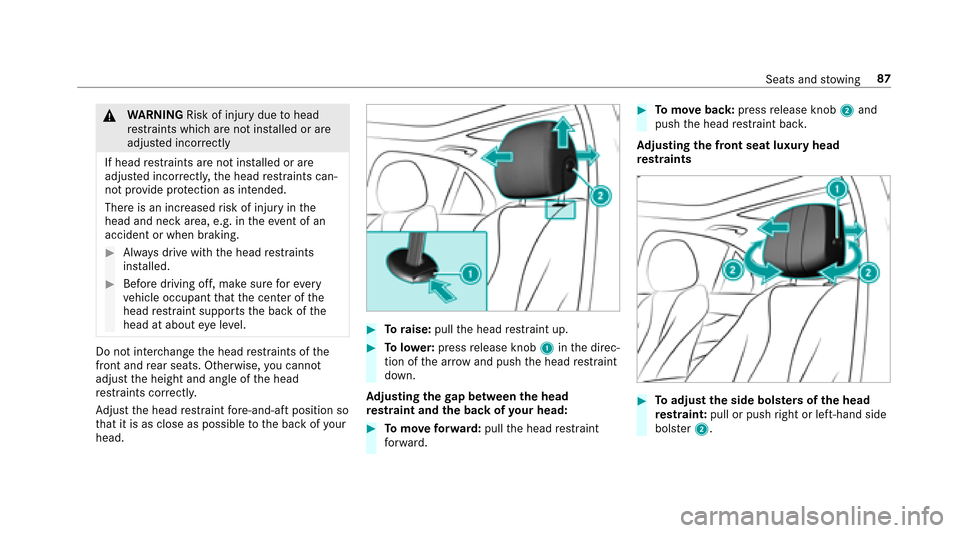
&WARNING Risk of injury duetohead
re stra ints which are not ins talled or are
adjus ted inco rrectly
If head restra ints are not ins talled or are
adjus ted incor rectly, the head restra ints can‐
not pr ovide pr otection as intended.
There is an increased risk of injury in the
head and neck area, e.g. in theeve nt of an
accident or when braking.
#Alw ays drive with the head restra ints
ins talled.
#Before driving off, make sure forev ery
ve hicle occupant that the center of the
head restra int supports the back of the
head at about eye le vel.
Do not inter change the head restra ints of the
front and rear seats. Otherwise, you cannot
adjust the height and angle of the head
re stra ints cor rectl y.
Ad just the head restra int fore -and-aft position so
th at it is as close as possible tothe back of your
head.
#To raise: pullthe head restra int up.
#To lowe r:press release knob 1inthe direc‐
tion of the ar row and push the head restra int
down.
Ad justing the gap between the head
re stra int and the back of your head:
#To mo veforw ard: pullthe head restra int
fo rw ard.
#To mo veback: pressrelease knob 2and
push the head restra int bac k.
Ad justing the front seat luxury head
re stra ints
#To adjust the side bols ters of the head
re stra int: pull or push right or left-hand side
bols ter2.
Seats and stowing 87
Page 97 of 482
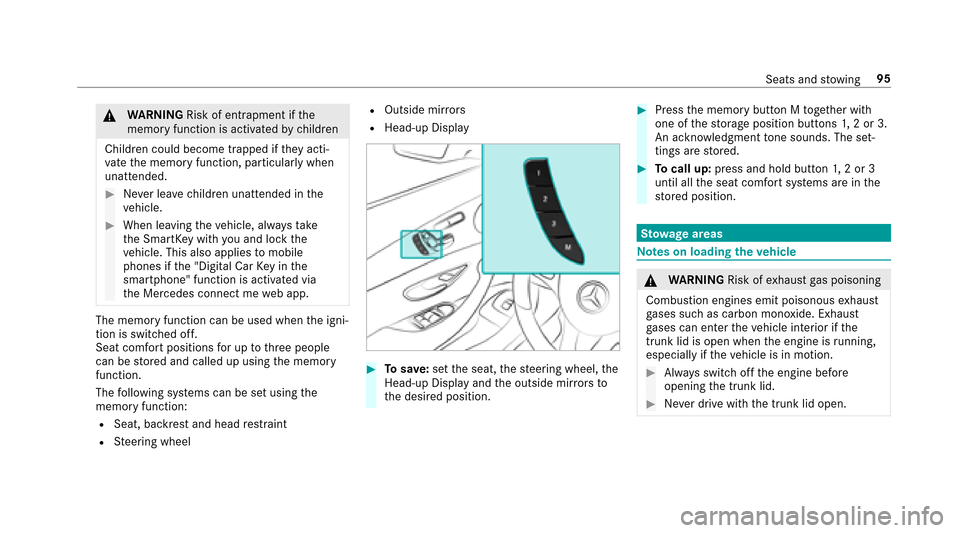
&WARNING Risk of entrapment if the
memory function is activated bychildren
Children could become trapped if they acti‐
va te the memory function, particularly when
unattended.
#Ne ver lea vechildren unatte nded inthe
ve hicle.
#When leaving theve hicle, alw aysta ke
th e SmartK eywith you and lock the
ve hicle. This also applies tomobile
phones if the "Digital Car Keyin the
smartphone" function is activated via
th e Mercedes connect me web app.
The memory function can be used when the igni‐
tion is switched off.
Seat comfort positions for up tothre e people
can be stored and called up using the memory
function.
The following sy stems can be set using the
memory function:
RSeat, backrest and head restra int
RSt eering wheel
ROutside mir rors
RHead-up Display
#To save :set the seat, thesteering wheel, the
Head-up Display and the outside mir rors to
th e desired position.
#Press the memory button M toge ther with
one of thestorage position buttons 1,2 or 3.
An acknowledgment tone sounds. The set‐
tings are stored.
#To call up: press and hold button 1,2 or 3
until all the seat comfort sy stems are in the
st ored position.
St ow age areas
Note s on loading theve hicle
&
WARNING Risk ofexhaust gas poisoning
Combustion engines emit poisonous exhaust
ga ses such as carbon monoxide. Exhaust
ga ses can enter theve hicle interior if the
trunk lid is open when the engine is running,
especially if theve hicle is in motion.
#Alw ays switch off the engine before
opening the trunk lid.
#Ne ver drive with the trunk lid open.
Seats and stowing 95
Page 106 of 482

Attachin gth ero of rack
&
WARNING Risk of injury by exceeding
th e maximum roof load
When you load thero of, theve hicle center of
gr av ity rises and the driving characteristics
ch ange.
If yo uexc eed the maximum roof load, the
driving characteristics, as well as thesteer‐
ing and braking, will be greatly impaired.
#Ne verexc eed the maximum roof load
and adjust your dr ivingst yle.
Yo uwill find information on the maximum roof
load in the "Technical data" section.
Re quirements
ROnly use roof rack ste sted and appr ovedby
Mercedes-Benz.
RMake sure that you can raise the sliding sun‐
ro of fully and open the trunk lid fully once
th ero of rack is ins talled.
RThe panoramic sliding sunroof cannot be
opened if a roof rack is ins talled. The panor‐ amic sliding sunroof closes again automati‐
cally when it encounters
resis tance.
* NO
TEDama getothe co vers
The co vers may be dama ged and scratched
when being opened.
#Do not use me tallic or hard objects.
#Fo ld co vers 1 carefully up wards in the
direction of the ar row.
#Only secure thero of rack tothe anchorage
points under co vers 1.
#Alw ays comply with thero of rack manufac‐
turer's ins tallation instructions.
#Secure the load on thero of rack .
Cup holder
Installing or removing the cup holder in the
center console
& WARNING ‑ Risk of accident or injury
when using the cup holder while the
ve hicle is moving
The cup holder cannot secure containers
while theve hicle is moving.
If yo u use a cup holder while theve hicle is
moving, the conta iner may be flung around
and liq uidsmay be spilled. The vehicle occu‐
pants may come into contact with the liquid
and if it is hot, they could be scalded. You
10 4
Seats and stowing